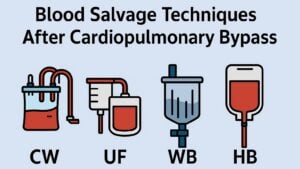Venoarterial extracorporeal membrane oxygenation (VA-ECMO) is a life-saving intervention for patients with cardiogenic shock or severe heart failure. While it provides critical circulatory and respiratory support, VA-ECMO increases left ventricular (LV) afterload, which can lead to left ventricular distension (LVD). LVD is a severe complication that can result in pulmonary edema, thrombus formation, ventricular arrhythmias, and even myocardial injury. The need for left ventricular unloading (LVU) to mitigate these risks is well-recognized, but there remains significant variability in determining the appropriate triggers for mechanical LV unloading.
This study presents a comprehensive literature review on the indicators, thresholds, and strategies for mechanical LV unloading in patients receiving VA-ECMO. The authors conducted a PubMed search to identify studies that discuss LVU criteria, uncovering inconsistencies in clinical, hemodynamic, and imaging-based definitions of LVD. Despite extensive research on unloading techniques, the optimal criteria for initiating mechanical unloading remain unclear.
Challenges in Identifying LV Distension
The literature reveals a lack of uniformity in how LVD is defined and detected. Clinicians rely on a combination of clinical signs, hemodynamic parameters, and imaging findings, but there is no universally accepted threshold for intervention.
Clinical Indicators
- Pulmonary edema
- Frothy secretions in the endotracheal tube
- Pulmonary hemorrhage
- Refractory ventricular arrhythmias
These symptoms often indicate advanced LVD, suggesting that earlier diagnostic criteria are needed to prevent irreversible myocardial damage.
Hemodynamic Indicators
- Increased pulmonary capillary wedge pressure (PCWP)
- Elevated pulmonary artery diastolic pressure (PAD)
- Low arterial line pulse pressure (ALPP)
Some studies suggest that a PCWP above 18-25 mmHg or PAD above 25 mmHg may indicate LVD. However, these thresholds vary across studies, and many institutions lack standardized criteria.
Imaging-Based Indicators
- Loss of aortic valve opening
- Echocardiographic signs of blood stasis
- Left ventricular outflow tract velocity time integral (LVOT VTI) reduction
- Thrombus formation in the left ventricle or aortic root
Echocardiography is frequently used to assess LV function, but different studies use varying thresholds for intervention. For example, some define a lack of aortic valve opening as a primary indicator for unloading, while others focus on the presence of echocardiographic “smoke” (blood stasis).
Current Approaches to Left Ventricular Unloading
Non-invasive and invasive LVU techniques exist, but the choice of intervention depends on institutional preferences and clinician experience.
Non-Invasive Approaches:
- Vasodilators to reduce afterload
- Diuresis to decrease LV volume
- Increasing positive end-expiratory pressure (PEEP)
- Decreasing VA-ECMO flow
These methods are often attempted before resorting to invasive mechanical unloading, particularly in patients without severe LVD symptoms.
Invasive Mechanical Unloading Techniques:
- Intra-aortic balloon pump (IABP): Reduces afterload and improves coronary perfusion but requires sufficient myocardial function to maintain aortic valve opening.
- Atrial septostomy: Creates a right-to-left shunt to reduce left atrial pressure, improving pulmonary congestion but not directly unloading the LV.
- Left atrial or LV drainage cannulas: Directly remove blood from the LV, reducing pressure and volume but requiring expertise in placement.
- Percutaneous transvalvular micro-axial pumps (Impella): Actively propel blood from the LV into the aorta, providing direct unloading but carrying risks of vascular complications.
Each strategy has its risks and benefits, and the absence of standardized criteria makes decision-making complex.
Gaps in Research and Future Directions
The study highlights the urgent need for standardized definitions and thresholds for LVD. While mechanical unloading is widely practiced, recent randomized controlled trials have not demonstrated a clear survival benefit. Some retrospective analyses suggest improved outcomes with LV unloading, but methodological limitations make it difficult to draw firm conclusions.
Future research should focus on identifying optimal hemodynamic and echocardiographic parameters to trigger LV unloading. Large-scale, multicenter studies comparing different unloading techniques are needed to establish best practices. Additionally, integrating invasive and non-invasive monitoring strategies may help clinicians detect LVD earlier and intervene before complications arise.
Conclusion
Left ventricular distension remains a major challenge in VA-ECMO management, and the decision to initiate mechanical unloading lacks uniform guidelines. Despite growing evidence supporting LV unloading, variability in definitions, monitoring strategies, and intervention thresholds complicates clinical decision-making. Standardizing these criteria is crucial for improving patient outcomes while minimizing unnecessary invasive procedures. As research progresses, developing a more structured approach to LV unloading will be essential for optimizing the care of VA-ECMO patients.
Study ranking = 4 (high quality) This study presents a thorough literature review on LV unloading in VA-ECMO patients, citing multiple sources and identifying research gaps. While it lacks original experimental data, its systematic analysis of existing studies makes it a valuable contribution to the field.







